Fermented foods have been a part of human diets for centuries, and with good reason. Not only do they offer a range of health benefits, but they can also be delicious additions to meals. One of the most notable benefits of fermented foods is their ability to improve gut health. The process of fermentation creates probiotics, which are beneficial bacteria that help to maintain a healthy balance in the gut microbiome. Here are the top seven fermented foods recipes for gut health, along with some recipes and tips for incorporating them into your diet.
How to Make Your Own Fermented Foods at Home
1. Yogurt
Yogurt is one of the most popular fermented food for gut health, and for good reason. It’s rich in probiotics and can help to improve digestion, boost immunity, and even reduce inflammation. When choosing yogurt, look for brands that contain live and active cultures, as these will have the highest probiotic content. You can also make your own yogurt at home using a yogurt maker or simply by combining milk and a yogurt starter culture and letting it ferment for several hours.
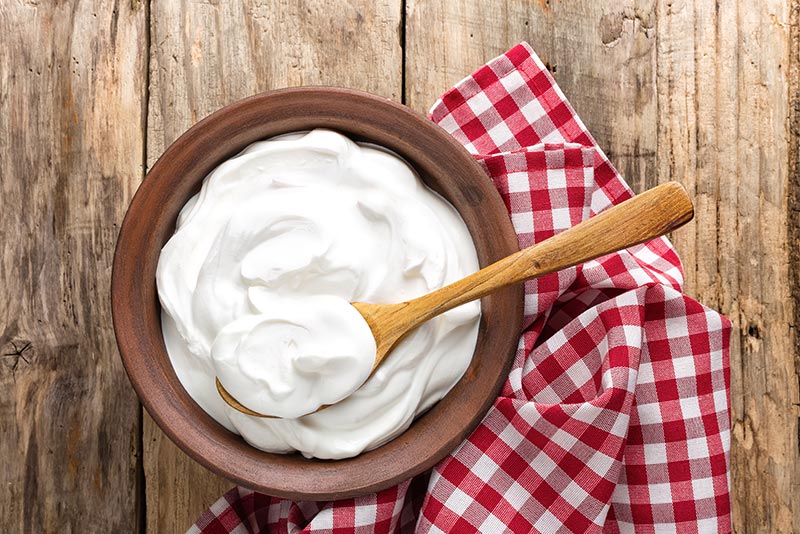
Recipe: Homemade Yogurt
Ingredients:
- 4 cups milk (whole or 2%)
- 2 tablespoons plain yogurt with live and active cultures
Instructions:
- Heat the milk in a saucepan over medium heat until it reaches 180°F.
- Let the milk cool to 110°F, then whisk in the yogurt.
- Pour the mixture into a jar or container and cover with a lid.
- Place the jar in a warm spot (such as an oven with the light on) for 6-12 hours, or until the yogurt has thickened.
- Chill the yogurt in the refrigerator before serving.
2. Kefir
Kefir is a fermented dairy drink that’s similar to yogurt but has a thinner consistency and a slightly tangier flavor. Like yogurt, it’s rich in probiotics and can help to improve gut health. Kefir can be found in many grocery stores, but it’s also easy to make at home using kefir grains, which are a mixture of bacteria and yeast.
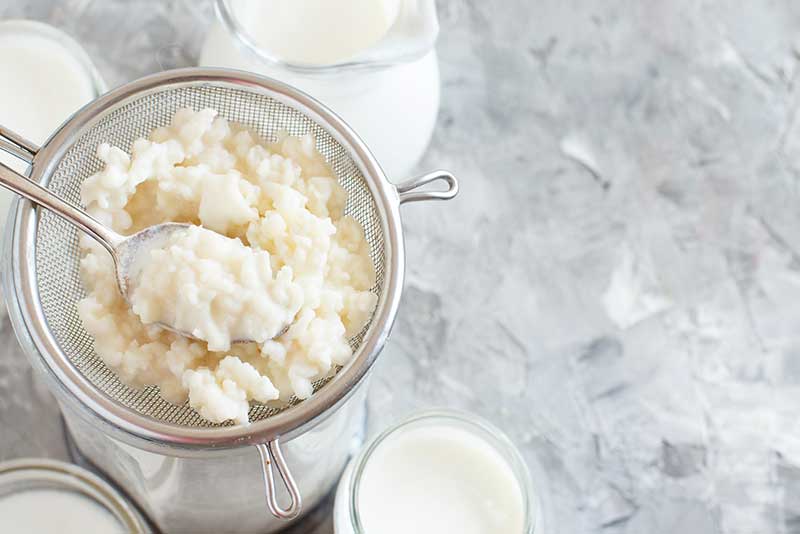
Recipe: Homemade Kefir
Ingredients:
- 4 cups milk (whole or 2%)
- 1 tablespoon kefir grains
Instructions:
- Heat the milk in a saucepan over medium heat until it reaches 180°F.
- Let the milk cool to 70°F, then add the kefir grains.
- Pour the mixture into a jar or container and cover with a lid.
- Place the jar in a warm spot (such as an oven with the light on) for 24-48 hours, or until the kefir has thickened.
- Strain out the kefir grains and store the kefir in the refrigerator.
3. Sauerkraut
Sauerkraut is a type of fermented cabbage that’s rich in probiotics and also high in vitamins C and K. It’s a popular addition to sandwiches and salads, and can also be eaten on its own as a side dish. You can find sauerkraut in most grocery stores, but it’s also easy to make at home using just cabbage and salt. Let’s take a look at this fermented food recipe for gut health.
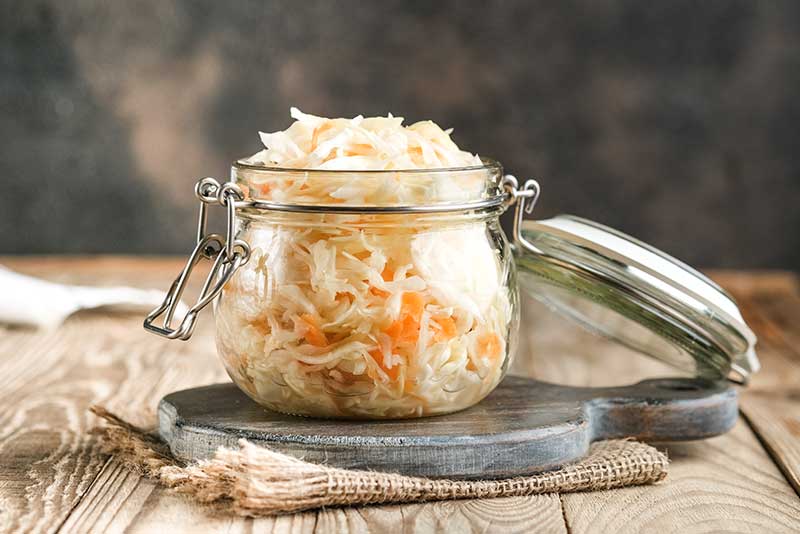
Recipe: Homemade Sauerkraut
Ingredients:
- 1 head of cabbage, shredded
- 1 tablespoon salt
Instructions:
- Combine the cabbage and salt in a large bowl and mix well.
- Let the mixture sit for 10-15 minutes, or until the cabbage starts to release its liquid.
- Pack the cabbage mixture into a jar or fermentation crock, pressing down firmly to release any air bubbles.
- Add enough water to cover the cabbage, then cover the jar with a lid.
4. Kombucha
Kombucha is a fermented tea drink that’s become increasingly popular in recent years. It’s made by fermenting sweetened tea with a symbiotic culture of bacteria and yeast, known as a SCOBY. Kombucha is a rich source of probiotics and can also help to detoxify the body and support the immune system. You can find bottled kombucha in most grocery stores, but it’s also easy to make at home using a SCOBY and some tea.

Recipe: Homemade Kombucha
Ingredients:
- 1 gallon water
- 8-10 tea bags (black or green tea)
- 1 cup sugar
- 1 SCOBY
Instructions:
- Bring the water to a boil, then remove from heat and add the tea bags and sugar.
- Let the tea steep for 15-20 minutes, then remove the tea bags and let the mixture cool to room temperature.
- Transfer the tea to a large glass jar and add the SCOBY.
- Cover the jar with a cloth or paper towel and secure with a rubber band.
- Place the jar in a warm spot (such as an oven with the light on) for 7-14 days, or until the kombucha has fermented to your liking.
- Remove the SCOBY and transfer the kombucha to airtight bottles for storage in the refrigerator.
5. Kimchi
Kimchi is a spicy Korean dish made from fermented vegetables, usually cabbage or radish, and seasoned with chili pepper, garlic, and other spices. It is another popular fermented food for gut health consumed by many people. It’s a great source of probiotics and can also help to lower cholesterol and boost immunity. Kimchi can be found in most grocery stores, but it’s also easy to make at home using just a few simple ingredients. Let’s take a look at this fermented food recipe for gut health.
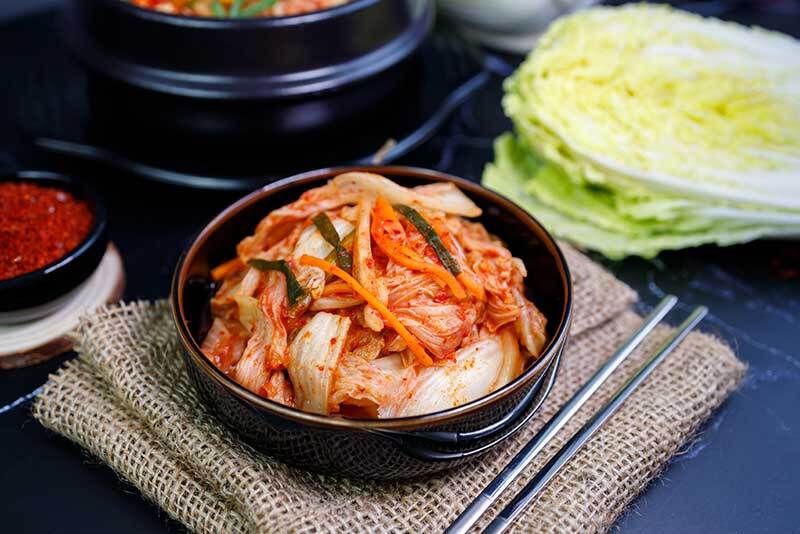
Recipe: Homemade Kimchi
Ingredients:
- 1 head of napa cabbage, chopped
- 1 tablespoon salt
- 1 tablespoon sugar
- 2 cloves garlic, minced
- 1 tablespoon grated ginger
- 1 tablespoon chili flakes
- 1 tablespoon fish sauce
- 2 scallions, chopped
Instructions:
- Combine the cabbage and salt in a large bowl and let sit for 2-3 hours, or until the cabbage has wilted.
- Drain the cabbage and rinse well, then transfer to a large mixing bowl.
- Add the sugar, garlic, ginger, chili flakes, fish sauce, and scallions, and mix well.
- Pack the mixture into a jar or fermentation crock, pressing down firmly to release any air bubbles.
- Cover the jar with a lid and let sit at room temperature for 2-3 days, or until the kimchi has fermented to your liking.
- Store the kimchi in the refrigerator.
6. Miso
Miso is a fermented soybean paste that’s commonly used in Japanese cuisine. It’s a great source of probiotics and can also help to lower blood pressure and reduce the risk of certain cancers. Miso can be found in most grocery stores, but it’s also easy to make at home using just soybeans and koji, a type of fungus.
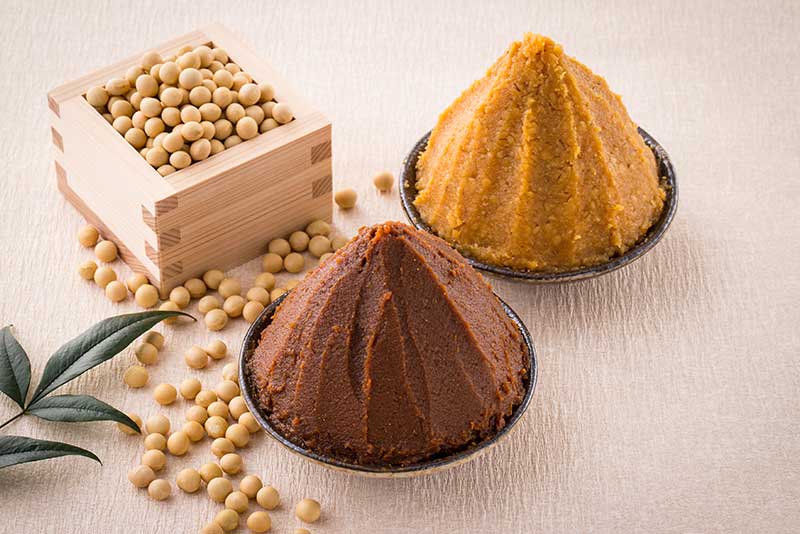
Recipe: Homemade Miso
Ingredients:
- 2 cups soybeans
- 2 cups koji
- 1/2 cup sea salt
Instructions:
- Instructions:
- Rinse the dried soybeans and soak them in water overnight or for at least 12 hours.
- Drain the soybeans and transfer them to a large pot with enough water to cover them by about 2 inches.
- Bring the soybeans to a boil over high heat, then reduce the heat to low and simmer for 2-3 hours, or until the soybeans are very tender and easily mashed.
- Drain the soybeans and let them cool to room temperature.
- Once the soybeans have cooled, add them to a blender or food processor and blend until smooth, adding a little bit of water as needed to create a paste-like consistency.
- In a large mixing bowl, combine the soybean paste with the koji and salt, mixing well to combine.
- Line a large airtight container with cheesecloth and transfer the miso paste to the container, pressing it down firmly to remove any air pockets.
- Fold the cheesecloth over the top of the miso paste to cover it completely, then cover the container with a lid or plastic wrap.
- Place the container in a cool, dark place for at least 6 months to allow the miso to ferment. The longer you let it ferment, the stronger and more flavorful it will become.
- Once the miso is ready, remove the cheesecloth and transfer the miso to an airtight container. It can be stored in the refrigerator for up to a year.
7. Pickles
Pickles are a popular fermented food that have been enjoyed for centuries. They are made by immersing cucumbers or other vegetables in a saltwater brine and allowing them to ferment for several days or weeks. The fermentation process creates a sour, tangy flavor and produces beneficial bacteria that can help to improve gut health.
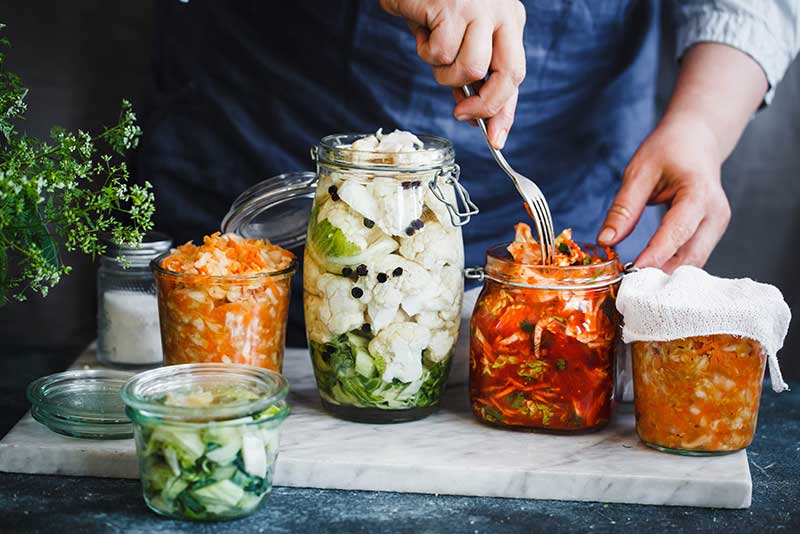
Recipe: Homemade Pickles
Ingredients:
- 1 pound cucumbers, sliced
- 1 tablespoon sea salt
- 2 cloves garlic, minced
- 1 tablespoon dill seeds
- 1/2 cup water
- 1/2 cup apple cider vinegar
Instructions:
- In a large bowl, toss the sliced cucumbers with the sea salt and let sit for 30 minutes to draw out excess water.
- Rinse the cucumbers well and transfer them to a clean jar with a tight-fitting lid.
- Add the minced garlic and dill seeds to the jar.
- In a separate bowl, whisk together the water and apple cider vinegar.
- Pour the vinegar mixture over the cucumbers, making sure they are fully submerged in the liquid.
- Cover the jar with a tight-fitting lid and let sit at room temperature for 3-5 days, or until the pickles are fermented to your liking.
- Once the pickles are fermented, store them in the refrigerator to slow down the fermentation process.
Takeaway
Fermented foods are an excellent way to improve gut health and support overall well-being. These foods are rich in probiotics, beneficial bacteria that can help restore balance to the gut microbiome, improve digestion, and reduce inflammation. We have mentioned some fermented food recipes for gut health that are also delicious. Fermented foods are also high in other beneficial compounds such as vitamins, minerals, and antioxidants, making them a healthy addition to any diet. By incorporating fermented foods such as kefir, yogurt, sauerkraut, kimchi, miso, kombucha, and pickles into your diet, you can support your gut health and promote optimal health and wellness.

Priyanka Khurana Goyal is a prominent Indian figure renowned for her diverse accomplishments and contributions across various fields.. Read more


